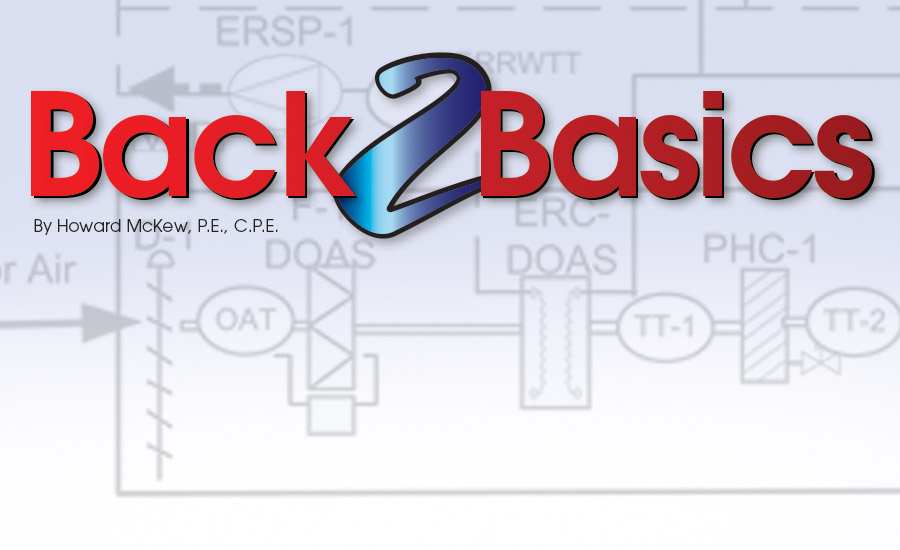This month’s B2B will focus on a small city school system that chose to invest in an annual contract for a temporary air-cooled chiller for special events and an emergency crisis shelter center. The original school HVAC design was a 2-pipe closed-circuit heating system, but sized to provide chilled water air conditioning to unit ventilators; two central AHUs; and fan coil units based on specific zoning of the school that included the gymnasium, cafeteria, auditorium, and 10 classrooms.
The school department chose this unique building program approach in order to work with the city on a business plan to minimize the first cost for construction of a new school, as well as to reduce annual maintenance costs associated with not having a permanent central chilled water system in the new school. The basis of design was to incorporate valve and capped connections at the school’s exterior equipment room wall in conjunction with a flatbed truck with an air-cooled chiller and electric generator to provide chilled water to the existing HVAC system. This cost-effective approach would provide cooling to the school for special events during the air conditioning season, as well as providing space comfort during a disaster relief incident for residents staying in a portion of the school with temporary sleeping quarters for such circumstances.
The existing building central hot water plant is adequate to accommodate the chilled water demands, so no changes were required other than switch the school’s BAS from heating to central cooling. The city outsourced the operation and maintenance of the school that included management of the mechanical and electrical systems during school special events and during a crisis using their in-house project management services.
Originally, when the school was in the design phase of construction, the design engineer refreshed her memory of HVAC school building design by reading the 2015 ASHRAE Handbook – HVAC Applications, chapter 7 (Educational Facilities) and chapters 36 through 43 (Building Operation and Management). Unfortunately, ASHRAE did not have a chapter addressing temporary HVAC design and O&M in its handbooks. The school building program basis of design for a temporary chilled water system design was new territory for the design team and the school’s project management team, but not for the companies that had experience providing temporary HVAC to schools, hospitals, industry, building infrastructure under renovation, etc.
The temporary air conditioning project delivery method involved a separate group of professionals within the city’s building management team that acted as a temporary air conditioning consultant to the new school construction design team. This management group was skilled in operation and maintenance of the mechanical and electrical systems and referred to the 2015 ASHRAE Handbook — HVAC Applications, chapter 58 (Integrated Building Design) as a guide to interface with the design team. The school’s building program would be design-bid-build (DBB) project delivery.
The DBB team would include the owner, building facility manager temporary AC consultant, third-party commissioning and air and water balancing consultant, architect, HVAC consultant engineer, electrical, plumbing, telecommunication, fire protection, and security sub-consultants, infection control (IC) consultant, and eventually, the successfully bidding general contractor with his subcontractors.
For this month’s HVAC application, the equipment selection is a 120-ton air-cooled chiller (ACC) to be contracted annually for temporary air conditioning service at the new school. ACC, when required, shall be delivered and remain on a flatbed truck while in service. Unit shall be furnished with a pre-piped chilled water pump sized for 240 gpm, 50-ft pump head, 20 hp constant speed with chilled water reset controls. Packaged automatic controls shall be BACnet compliant with interface hookup connections to the school’s BAS computer and remote access to the BAS from the city’s project management department. Controls shall include all internal unit controls, safeties, alarm, flow switch, scheduling, and energy management features. ACC shall be connected using 20-ft flexible hose insulated pipe at the equipment room along with the electrical power and BAS connections. The chilled water shall be 44˚F CHWS and 55˚F CHWR. Electrical shall be 480/3/60 electrical power to the unit and shall be furnished as part of the temporary chiller contract (not part of this B2B test).
Unit shall be furnished with all required temperature and pressure gages, water strainers, flow switches, safety controls and alarms, and shutoff valves. ACC contractor shall be responsible for each unit delivery, startup, maintenance, and unit removal.
General Contractor shall include the following shop drawing submittal data:
- Equipment submittals - Unit ventilators - Fan coil units – Air handling units - Pump curves -Startup sheet - Troubleshooting sheets - O&M manuals, parts, and lubricants - ATC and energy management submittal, including one complete ATC submittal integrating manufacturer’s chiller unit-furnished ATC with overall ATC submittal.
A third-party commissioning and TAB firm shall complete the following:
- TAB system flow diagram of entire hot water system and the zone/ limited chilled water system with gpm and pumps heads indicated at each piece of equipment.
- TAB system flow diagram of entire school supply, return, and exhaust air systems, with cfm and static pressures at each piece of equipment and at major branch runouts as it enters and leaves the duct shaft.
- Commissioning functional performance test of HVAC systems (heating and central air systems and HVAC interface with security system). Refer to The Facility Files for additional information pertaining to completing the B2B test.




